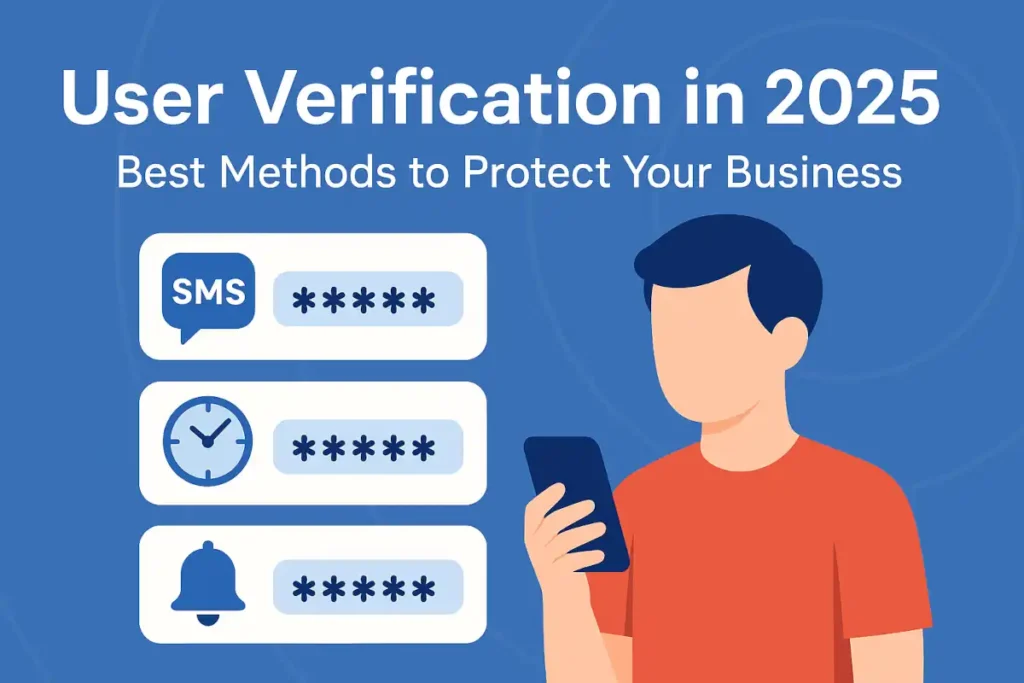User Verification in 2025: How It Can Safeguard Your Business
⏱ Reading time: ~6 minutes
In today’s digital world, strong user verification isn’t just a technical feature — it’s a vital shield against fraud, data breaches, and reputational damage.
This article explores how businesses can use channels like SMS, TOTP, and Push notifications to verify users reliably — often as part of a secure 2FA strategy — and why choosing the right method has become essential in 2025.
Here’s what we’ll cover:
Why Verification Matters
Main Verification Methods
Choosing the Right Verification Method
FAQs
Why Verification Matters in 2025
In today’s hyper-connected world, digital threats evolve faster than ever.
Weak or missing user verification isn’t just a technical flaw — it opens the door to fraud, financial loss, and damaged trust.
Recent industry data highlights just how high the stakes are:
- Cybercrime damages are projected to reach $10.5 trillion annually by 2025 (Cobalt.io).
- 19% of all data breaches are caused by compromised credentials (Strongdm.com).
- The average cost of a single breach is already around $4.88 million (Vikingcloud.com).
As a result, businesses must rethink their user verification strategies.
Effective user verification — especially when implemented through robust 2FA methods — isn’t just about ticking a security box. It’s about protecting your users, safeguarding your brand’s reputation, and enabling secure business growth in a risky digital world.
With growing risks, choosing the right verification method isn’t just important — it’s essential for protecting your business and earning customer trust.
Comparison of Common User Verification Methods
To better understand your options, here’s a comparison between the most common verification methods:
| Method | How It Works | Advantages | Drawbacks | Best For |
|---|---|---|---|---|
| SMS Code | One-time code sent via SMS | Widely accessible, easy to deploy | Potential delays, SMS fraud risks | Mass-market onboarding |
| TOTP App | App-based time-generated codes | High security, offline capability | Requires installation, complex recovery | Financial apps, corporate accounts |
| Push Notification | User approves via app notification | Fast, can integrate biometrics | Needs app + internet | Banking, secured platforms |
| Email Code | Code sent to user’s email | Low cost, broad reach | Slower, vulnerable to phishing | Low-risk registrations |
| Silent Network Auth | Carrier-based silent verification | Seamless UX, strong fraud protection | Limited coverage, higher cost | Specialized cases |
While SMS remains a leading channel for user verification, other messaging platforms like Viber and WhatsApp are also being explored for authentication flows.
To understand their advantages and limitations compared to SMS, check out our detailed comparison: SMS vs Viber vs WhatsApp: Which Is the Best Solution for Business Messaging?
Choosing the Right Verification Method
The right method depends on balancing security, user experience, and cost. This table helps compare:
| Criteria | SMS | TOTP | Push | Silent Auth | |
|---|---|---|---|---|---|
| Accessibility | ★★★★☆ | ★★☆☆☆ | ★★★☆☆ | ★★☆☆☆ | ★★★★☆ |
| Security | ★★☆☆☆ | ★★★★☆ | ★★★★☆ | ★★★★★ | ★★☆☆☆ |
| Convenience | ★★★☆☆ | ★★☆☆☆ | ★★★★☆ | ★★★★★ | ★★★☆☆ |
| Cost | ★★☆☆☆ | ★★★★☆ | ★★★☆☆ | ★★☆☆☆ | ★★★★★ |
Push notifications are increasingly used not just for engagement, but for user verification too. Curious how they compare with In-App Messaging? Check out our article: In-App vs Push Notifications.
Frequently Asked Questions
Q: What’s the difference between SMS and push?
A: SMS works on any phone, even without an app or internet. Push requires an app and data.
Q: Is TOTP safer than SMS?
A: Yes, TOTP is generally more secure, but it’s harder to use for casual users.
Q: Is email enough?
A: Not for sensitive accounts. It’s best used with a second factor like SMS or TOTP.
Q: Why are SMS codes sometimes delayed?
A: Delays are rare. At Procode, we actively monitor delivery routes to ensure reliability across regions through our partnerships with trusted messaging providers.
Q: Is Silent Auth the future?
A: It’s promising — but limited in global reach and still costly for many use cases.
Conclusion
In conclusion, strong, user-friendly verification — often achieved by thoughtfully combining methods like SMS, TOTP apps, and Push notifications — is the foundation of digital trust and long-term protection.
To support this need, Procode empowers businesses with fast, scalable, and highly reliable messaging solutions — helping them deliver secure, user-friendly verification experiences across SMS, Viber, WhatsApp, and more.
📌 Want to make your 2FA and verification flows faster and more secure?


